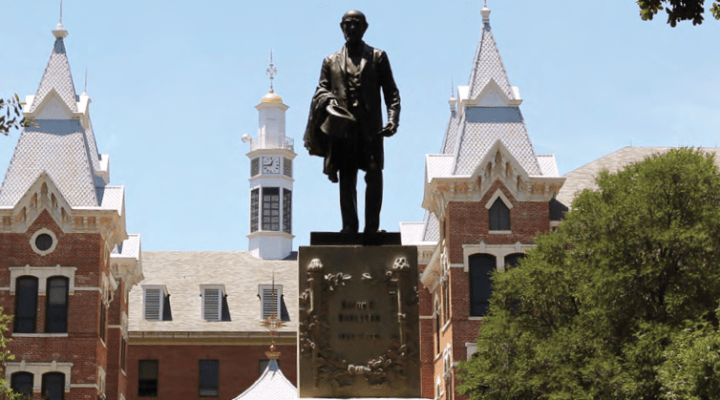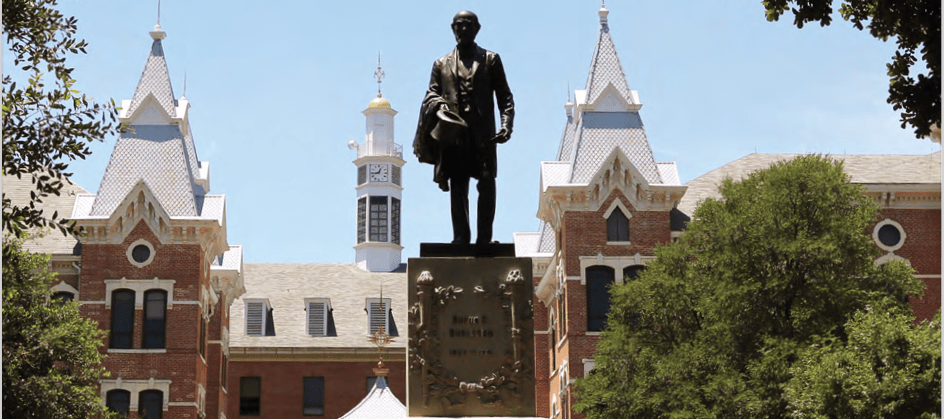Baylor University will retain the name of its slave-holding founder along with the prominent statue dedicated to its namesake, the Baptist-affiliated institution said March 23 in releasing a much-anticipated report detailing with its historic ties to slavery and the Confederacy.
However, the university intends to erect two statues honoring its pioneering Black graduates, will consider relocating or revising other historical markers on campus and is considering a wide range of other recommendations made by the Commission on Historic Campus Representations in a 90-page report.
The commission recommended that incoming Baylor students be presented with thorough information about the school’s history during orientation each year. It also suggested the renaming of Burleson Quadrangle and the relocation of the Rufus Burleson’s monument to an out-of-the-way location.
The university intends to erect two statues honoring its pioneering Black graduates.
University officials did not provide a timeline for the possible implementation, rejection or modification of these and other recommendations that followed the commission’s five-month research process ending in December 2020. The Baylor board of regents accepted the report in February and directed the administration to consider its suggestions and develop an action plan.
An ‘additive approach’
Through its recommendations, the commission sought to respond to the troubling aspects of Baylor’s history by illuminating the past rather than by removing statues and monuments, Board Chairman Mark Rountree said during a virtual news conference.
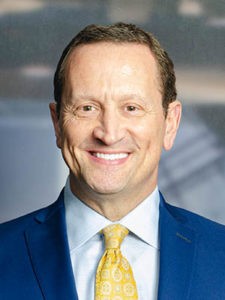
Mark Rountree
“They took an additive, rather than subtractive, approach to making recommendations as to how we can tell this aspect of our history and to represent that history in a more complete way around our campus,” Rountree said.
In releasing the report, the university said it will retain the Baylor name. While consideration of a name change never was part of the commission’s charge, President Linda Livingstone said the statement was added to dispel any notion it was a possibility.
“We continue to get a lot of questions about that from individuals,” she said during the news conference.
Livingstone added that the university already is moving ahead with plans to erect statues of Robert Gilbert and Barbara Walker, both of the class of 1967, in front of Tidwell Bible Building. The statues will commemorate the pair for helping integrate Baylor as its first Black graduates. A design for the statues may be completed by late summer or early fall.
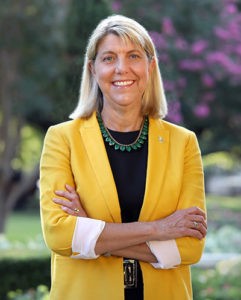
Linda Livingstone (Photo/Baylor)
The commission had recommended the university “create an intentional honoring of people of color who have contributed to Baylor’s history with statues or other installations on campus.”
Livingstone said statues of the late Gilbert and Walker will be a positive first move in that direction. “We see the commission report as an initial step to rebuild a foundation for building out and more fully telling the complete history of Baylor.”
An honest review of the founders
But it is the history of the institution’s founders that makes up the bulk of the commission report, which also provides a rich narrative of the social and economic backdrop of Baylor’s founding in 1845, as well as biographical background for Judge R.E.B. Baylor, co-founders James Huckins and William Tryon, and Burleson, president of the university from 1851 to 1861.
The commission offered guidance on how to appropriately address the monuments and markers located in Founders Mall.
“There is a need to publicly and visibly state that Baylor’s founders were flawed in regard to their views and attitudes toward the enslavement of people and support of the Confederacy,” the report states. “Although such views and attitudes were acceptable at that time by many people across the South and in Texas, they do not align with God’s word.”
 Baylor could seek repentance and reconciliation by acknowledging that contradiction and the pain and death inflicted on enslaved persons by its founders, the commission said.
Baylor could seek repentance and reconciliation by acknowledging that contradiction and the pain and death inflicted on enslaved persons by its founders, the commission said.
“New information about the founders should be provided to identify them as owners of enslaved persons, thereby adding key elements of information currently missing from their personal histories. In addition, there is a need to tell a more complete story of Baylor’s founding and early history that recognizes the role played by slave labor in building Baylor’s early campus on Windmill Hill and Academy Hill in Independence, Texas.”
Adding a new monument
To do that, the commission recommended a new monument dedicated to “the unknown enslaved” be placed in the heart of Founders Mall: “Such a new historic representation would begin to change the way Black and brown people feel when they walk on Baylor’s campus and would symbolize Baylor’s commitment to racial diversity going forward.”
The proposed monument also would give context to another nearby marker by including “information regarding the fact that 11 of the 15 men constituting Baylor University’s first board of trustees were owners of enslaved people,” the commission suggested.
The report also recommended removing text from the statue of Judge Baylor, which declares him as “PRO ECCLESIA” — or pro church. If not removed, then language should be added for context about his Baptist faith.
“Judge Baylor was pro church — but it was a church that supported slavery and unjust treatment to men, women and children based on the color of their skin,” the report states. “There is no evidence in God’s word supporting injustice and inhumane treatment of Black persons; therefore, to preserve the honor and credibility of Baylor University’s commitment to the Christian faith, this statement must be removed or further explained.”
“Judge Baylor was pro church — but it was a church that supported slavery and unjust treatment to men, women and children based on the color of their skin.”
Other recommendations related to Founders Mall include moving or combining the monuments of co-founders Tryon and Huckins and adding historical detail about them. The two men were recognized for their leading roles in the launch of the Southern Baptist Convention, created in 1845 as a home for pro-slavery Baptists.
“The text on the Tryon and Huckins Monuments is fairly straightforward, but it does not tell the whole story of the two founders’ relationship and attitude toward slavery, their ownership of slaves, and Huckins’ involvement with the Confederacy,” the report says.
Concern about Burleson name
The commission took particular issue with the prominent statue of Burleson for the same reason: “Burleson’s beliefs supporting the dehumanization, unjust treatment and degradation of Black people and his demonstrated commitment to the institution of slavery and the Confederate Army’s role in the Civil War — in addition to his support, leadership and involvement in the ‘Lost Cause’ movement following the Civil War — fail to align with Baylor’s Christian commitment.”
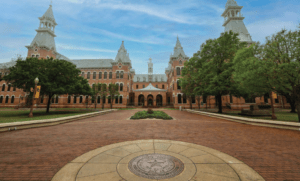 The commission recommended renaming the high-traffic location the “Baylor Family Quadrangle” or some other more-welcoming title, and that the statue be relocated to a less prominent location on campus.
The commission recommended renaming the high-traffic location the “Baylor Family Quadrangle” or some other more-welcoming title, and that the statue be relocated to a less prominent location on campus.
Renaming the quadrangle is an idea that makes a lot of sense, said Joseph C. Parker Jr., senior pastor at David Chapel Missionary Baptist Church in Austin, Texas, and the first African American graduate of Baylor’s George W. Truett Theological Seminary.
“A quadrangle is a gathering place that, in a sense, is also spiritual place,” Parker said. “There is an experience of fellowship taking place in that spot, and I would not want to continue to honor his (Burleson’s) presence there.”
He also welcomed news that Baylor plans to erect monuments dedicated to the university’s Civil Rights pioneers. “Statues, at the very least, engender conversation, and to have those statues in a prominent place requires people to acknowledge their role in Baylor becoming a place of equity and equality.”
But Parker added that he hopes the university will take the additional step of seeking to make reparations to the descendants of slaves owned by its founders. “This is about Black folks in America and there needs to be something specific done for that group.”
History of the commission
The Commission on Historic Campus Representations was established with a June 2020 Baylor board of regents racial healing and justice resolution acknowledging the university’s historical connection to the Confederacy and slavery.
The 26-member, racially diverse commission included faculty, staff and students charged with analyzing the slave-holding practices of Baylor founders and early leaders, and their roles in the Confederacy. Their ensuing report was to offer recommendations to the regents regarding the original naming and intention of those buildings, monuments, statutes and other campus features dedicated to the university’s mid-1800s founding.
In the weeks leading up to the report, the university hosted a virtual conversation series that covered the history of slavery in the U.S. and in Texas and unpacked Baylor’s founders’ part in that history.
During the third and final installment, commission co-chairs Walter Abercrombie, Alicia Monroe and Gary Mortenson shared about the pain they and other members experienced exploring the connections between the slave economy of the South and Baylor’s establishment.
Related articles:
Co-chairs of Baylor commission on historic representations say their research was distressing
Baylor regents ‘accept’ racial history report, will release findings by end of March
Alumni applaud Baylor University’s pledge to explore racist roots
Tearing down statues doesn’t erase history | Opinion by Ella Wall Prichard
Baylor not yet where it wants to be on race, Livingstone tells forum

